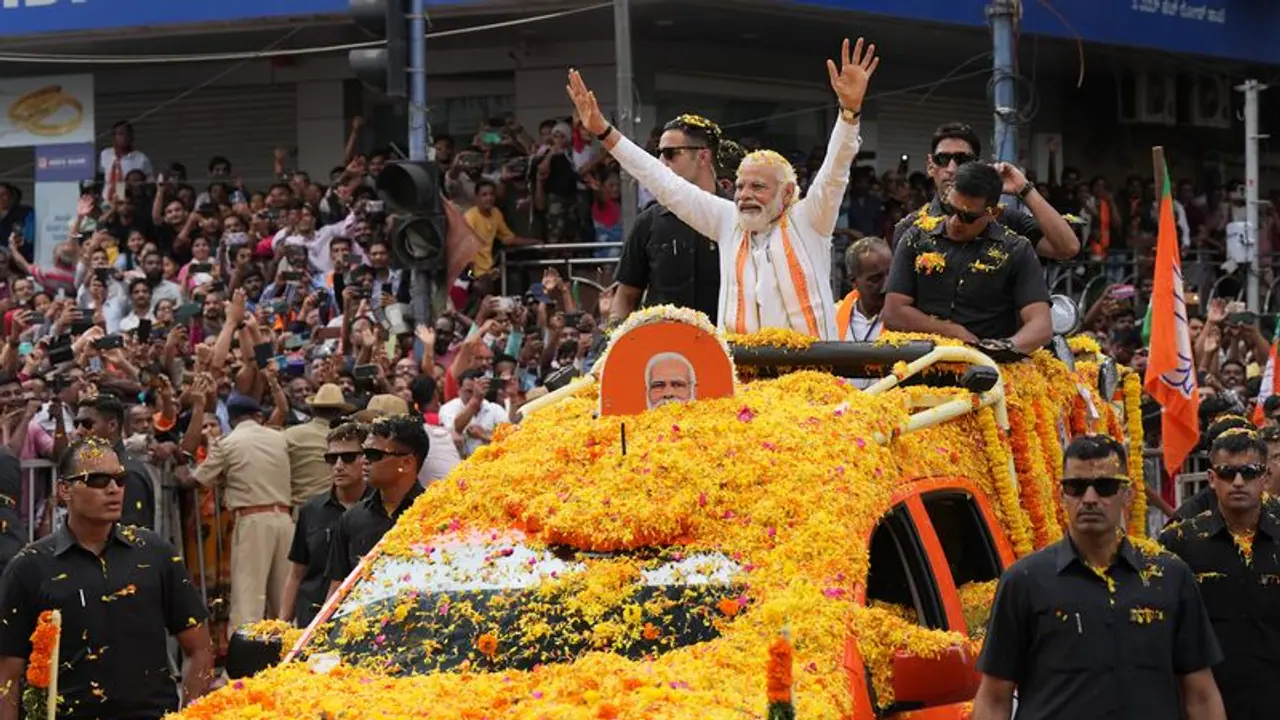Exit polls on Saturday predicted a historic third term for Prime Minister Narendra Modi as the seventh and final phase of the Lok Sabha Elections 2024 concluded.
Exit polls on Saturday predicted a historic third term for Prime Minister Narendra Modi as the seventh and final phase of the Lok Sabha Elections 2024 concluded. While no exit poll has yet predicted that the NDA will achieve its dream score of 400 out of 543 seats, several exit polls collectively indicate that the INDIA Bloc will be left far behind.

The highest number of seats predicted for the NDA comes from the Jan ki Baat exit poll, which forecasts 362-392 seats for the alliance, while predicting 141-161 seats for INDIA Bloc.
India News-D Dynamics follows, predicting 371 seats for the NDA and 125 seats for the INDIA Bloc.
The lowest score for the NDA comes from Dainik Bhaskar -- 281-350, and a corresponding higher score for the INDIA Bloc, 145-201 seats.
Lok Sabha Elections 2014 Exit Polls:
| Source | NDA | INDIA Bloc | Others |
| Jan Ki Baat | 362-392 | 141-161 | 10-20 |
| News Nation | 342-378 | 153-169 | 21-23 |
| Republic Bharat-Matrize | 353-368 | 118-133 | 43-48 |
| Republic TV - P MARQ | 359 | 154 | 30 |
| Dainik Bhaskar | 281-350 | 145-201 | 33-49 |
| India News-D-Dynamics | 371 | 125 | 47 |
While acknowledging the occasional inaccuracies of exit polls, all polls unanimously indicate an improved performance for the NDA in the south and in Bengal. In Andhra Pradesh, the alliance with Chandrababu Naidu is anticipated to yield dividends, with the NDA expected to secure 18 of the state's 25 seats.
Karnataka is also projected to heavily favor the BJP, despite the state's historical preference for the Congress.
In Bengal, the BJP is anticipated to increase its 2019 tally of 18 seats to 22.
However, changes are anticipated in Bihar, which had previously awarded 39 of its 40 seats to the NDA. The Opposition alliance, led by Tejashwi Yadav's Rashtriya Janata Dal, is expected to snatch away 7 seats.
Voting in the final phase will conclude at 6 pm on Saturday, with exit poll results going live at 6:30 pm. These exit polls will offer early predictions for this year’s general election outcomes ahead of the official results, which the Election Commission of India (ECI) will announce on Tuesday, June 4.
Exit polls provide an indication of how people voted in the election, based on interviews conducted with voters immediately after they leave the polling stations.
Here is a comparison of the exit poll projections and the official results from the 2014 and 2019 Lok Sabha elections, highlighting which pollsters came closest to predicting the final outcomes.
Lok Sabha Elections 2019 Exit Polls:
| BJP+ | Congress+ | Others | |
| VMR-Times Now | 306 | 132 | 104 |
| C-Voter | 287 | 128 | 127 |
| Axis My India-India Today | 352 | 93 | 82 |
| AC Nielsen-ABP | 277 | 130 | 135 |
| Today's Chanakya-News 24 | 340 | 70 | 133 |
| IPSOS-News 18 | 336 | 82 | 124 |
Lok Sabha Elections 2019 Official Results:
- NDA: 352 seats, of which the BJP won 303 seats
- UPA: 91 seats, of which the Congress won 52 seats
Lok Sabha Elections 2014 Exit Polls:
| Source | BJP+ | Congress+ | Others |
| Times Now-ORG | 257 | 135 | 151 |
| CNN-IBN-CSDS | 276 | 97 | 170 |
| Headlines Today-Cicero | 272 | 115 | 156 |
| ABP News-Nielsen | 281 | 97 | 165 |
| News 24 Today's Chanakya | 340 | 70 | 133 |
| CVoter-India TV | 289 | 101 | 153 |
Lok Sabha Elections 2014 Official Results
- NDA: 336 seats, of which the BJP won 282 seats
- UPA: 60 seats, of which the Congress won 44 seats
Exit polls have shown a mixed track record in capturing electoral outcomes in India. The 2014 polls were largely successful in gauging public sentiment, correctly forecasting a strong showing by the BJP-led NDA, which secured a majority with 282 seats. However, the 2009 and 2004 elections saw significant discrepancies between exit poll predictions and actual results.
In 2009, the UPA surpassed exit poll projections, winning 262 seats, well above the highest forecast of 205. Similarly, in 2004, exit polls failed to anticipate the NDA's defeat by the UPA.
Exit polls serve as a tool to measure public opinion, but their precision depends on various factors such as the number of participants, the areas surveyed, and the willingness of voters to be candid. Analyzing voting trends within specific groups can provide insights, but the possibility of voters not disclosing their genuine choices can lead to potential discrepancies.
Over time, exit polls have demonstrated varying levels of reliability, with some instances of accuracy and others of inaccuracy. The effectiveness of exit polls heavily relies on the methodology employed.
In past elections, exit polls have had a checkered record in predicting results. While some have been successful in providing a close approximation of the final tally, others have significantly missed the mark. This inconsistency underscores the challenges inherent in relying solely on exit polls as a predictive tool.
According to Section 126A of the Representation of the People's Act, 1951, it is illegal for news channels and pollsters to disclose exit poll results before the completion of the last phase of voting. Violating this rule could result in a maximum prison sentence of two years, a monetary penalty, or both. Releasing exit poll numbers prematurely is strictly prohibited by law. This legislation aims to ensure that the voting process remains unbiased and uninfluenced by early predictions or projections. The severe consequences for breaching this regulation underscore the importance of maintaining the integrity of the electoral process.
